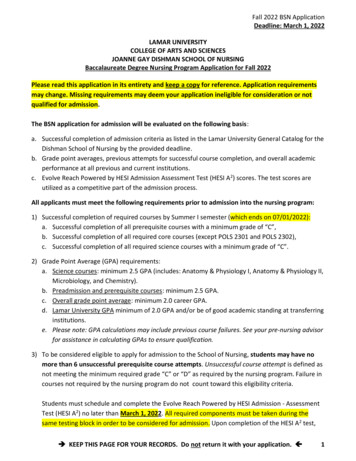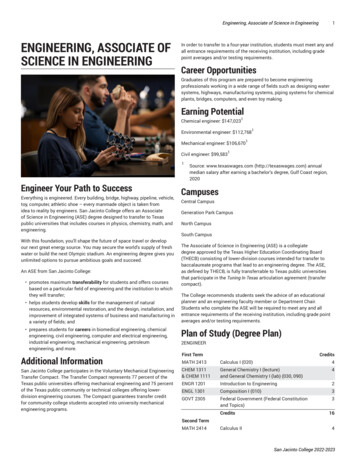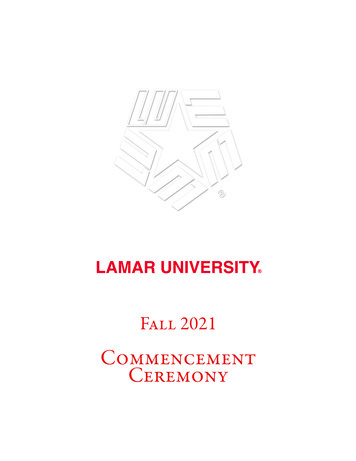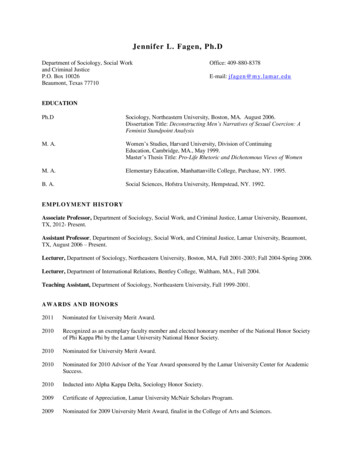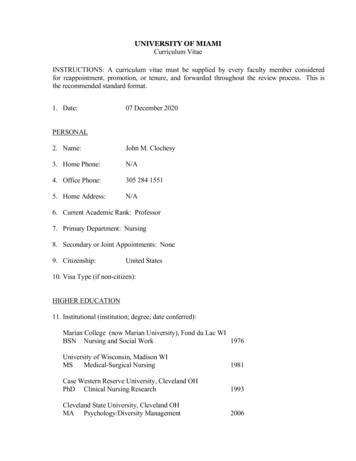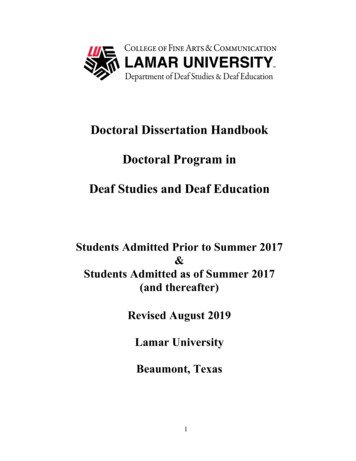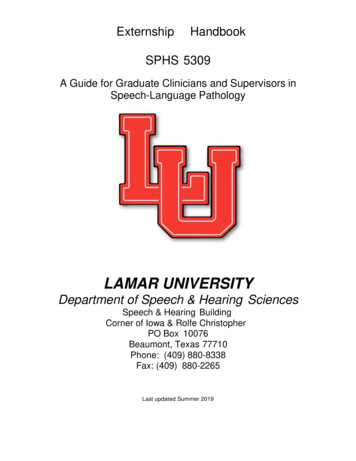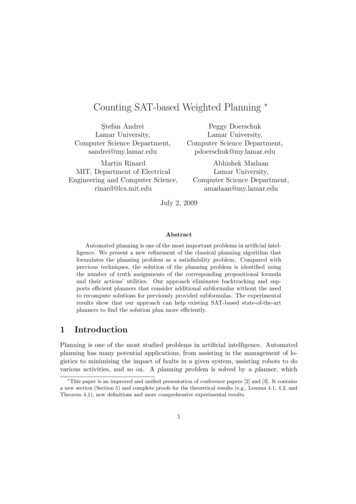
Transcription
CURRICULUM VITAENovember, 16th 2019Selahattin Sayil, Ph.D.ProfessorDrayer Department of Electrical EngineeringLamar University, Beaumont, Texas 77710E-mail: ssayil@lamar.eduPhone: (409) 880-8756; Fax: (409) 880-8121Years of teaching at college level: Nineteen (19) YearsYears of teaching at Lamar: Sixteen (16) YearsEDUCATION: Ph.D. in Electrical and Computer Engineering, (1996-2000),Vanderbilt University, Nashville, TN, USA M. Sc. in Electrical and Computer Engineering, (1994-1996).Pennsylvania State University, State College, PA, USAPROFESSIONAL EXPERIENCE August 2017- PresentProfessorDepartment of Electrical EngineeringLamar University, Beaumont TX August 2009- August 2017Associate ProfessorDepartment of Electrical EngineeringLamar University, Beaumont TX June 2003- August 2009Assistant ProfessorDepartment of Electrical EngineeringLamar University, Beaumont TX February 2001- May 2003Department ChairElectronics & Computer Education DepartmentPamukkale University, Denizli, TURKEY September 2000- May 2003Assistant ProfessorElectronics & Computer Education DepartmentPamukkale University, Denizli, TURKEY1
TEACHING INTERESTSOnline Teaching, Web-based learningOnline labs, Integrating Lab experiences into Theory coursesStudy Abroad opportunitiesRESEARCH EXPERTISERadiation Effects Modeling in Integrated CircuitsLow Power Design & Reliability AnalysisInterconnect Noise & Delay Prediction and ModelingContactless VLSI TestingHONORS, AWARDS, AND APPOINTMENTS Distinguished Faculty Teaching Fellow, Lamar University (2018-2021) Associate Editor for International Journal of Electronics (2008-present) Corresponding Editor for IEEE Potentials (2008) Research Enhancement Grant Awards obtained from Lamar University Promoted to Department Chair position, Electronics & Computer Education Department,Pamukkale University, Denizli, TURKEY, Feb 2001- May 2003. Teaching and Research Assistantships awarded from Vanderbilt University (1999), (1998). Graduated first in rank among the graduates of Gazi University Electronics Dept, Summerof 1990. In the Science Weighted scoring, scored among the top 1% entrants in nation-wideuniversity entrance Exam in Turkey. Nearly 500,000 students had taken the exam.PUBLICATIONS:I have authored 2 books, 2 book chapters and published about 30 refereed journal articles thatinclude special feature articles. Some papers appeared on journal covers. I have also presented atmany international conferences.2
BOOK PUBLICATIONS(1) Sayil, S., “Soft Error Mechanisms, Modeling and Mitigation”, Publisher: Springer, NewYork, NY, 2016. http://www.springer.com/us/book/9783319306063This text included collection of my research over last eight (8) years and received very positivereviews (see the book review @ “Microelectronics Reliability” journal, vol. 74, pg 81, ). In the 2017 book review published, researchersfrom "Broadcom Limited" and "Sandisk Storage" industries state that "the book is a veryinformative reference to memory device reliability engineers", "The book is valuable as a learningtool for memory device level SER and its clear relevance to real-world industry practices makes ituseful for both students and device reliability practitioners."(2) Sayil, S. “Contactless Measurement and Testing Techniques”, 2018, Springer Publishing,NY. (www.springer.com/us/book/9783319696720)This book provides a comprehensive overview of the state-of-the-art contactless probingtechniques and diagnostic measurement methods for VLSI and fills a gap in the literature on VLSITesting.BOOK CHAPTER PUBLICATIONS(1) “VLSI: Circuits for Emerging Applications”, Publisher: CRC Press, October 24, 2014,ISBN 9781466599093 (hardcover)Chapter 13.3- Selahattin Sayil, Lamar University,Title: “Soft-Error-Aware Power Optimization Using Dynamic Threshold”, pages 295-310This book is written by well-known international experts in industry and academia. Some authorsin this book are affiliated with IBM, Texas Instruments, and Intel. Faculty authors are from manycountries including Japan, France, UK, Germany, Italy and well known universities in U.S.(2) “Advanced Circuits for Emerging Technologies”, Publisher: Wiley, Publication Date:May 2012, ISBN-10: 0470900059 (hardcover)Chapter 23 - Selahattin Sayil, Lamar UniversityTitle: “Contactless Testing and Diagnosis Techniques”, pages 581-597.This book is written by well-known international experts in industry and academia. Some authorsin this book are affiliated with IBM, Texas Instruments, Broadcom and Synopsys.3
REFEREED JOURNAL PUBLICATIONS:Most papers published are with Lamar Students (shown as underlined). Sayil, S., “A survey of circuit-level soft error mitigation methodologies”, Analog IntegratedCircuits and Signal Processing, vol. 99, no. 1, pp. 63-70, April 2019. Sayil, S., Bhowmik, P. “Mitigating the thermally induced single event crosstalk”, AnalogIntegrated Circuits and Signal Processing, vol. 92, no. 2, pp. 247–253, August 2017. Sayil, S., Shah, A.H. , Zaman, M.A., Islam, M.A.,"Soft Error Mitigation using Transmission Gatewith varying Gate and Body Bias", IEEE Design and Test, vol. 34, no. 1, pp. 47-56 , Feb 2017. Sayil, S., Yao, Y., “Single Event Coupling Delay Estimation in Nanometer Technologies",Analog Integrated Circuits and Signal Processing, vol. 86, no:2, pp. 215-225, February 2016. Sayil, S., Yuan, Li, “Modeling Single Event Crosstalk Speedup in Nanometer Technologies”,Microelectronics Journal, Volume 46, Issue 5, pp. 343–35, May 2015 Sayil, S., Wang, J., “Coupling Induced Soft Error Mechanisms in Nanoscale CMOStechnologies”, Analog Integrated Circuits and Signal Processing, Volume 79, Issue 1, pp. 115126, April 2014. Sayil, S., Wang, J. Yeddula, S. R., “Single Event Coupling Soft Errors in Nanoscale CMOSCircuits”, IEEE Design and Test, Volume 30, Issue: 6, pp. 1-9, December 2013. Sayil, S., Boorla, V. K., “Single Event Crosstalk Prediction in Nanometer Technologies”Analog Integrated Circuits and Signal Processing, July 2012, Volume 72, Issue 1, pp 205-214. Sayil, S., Wang, J., “Single Event Soft Errors in CMOS Logic”, IEEE Potentials, Volume: 31,Issue: 2, Page(s): 15 – 22, April 2012 Sayil, S., Boorla, V.K.,Yeddula, S.R., “Modeling Single Event Crosstalk in NanometerTechnologies”, IEEE Transactions on Nuclear Science, Volume: 58 , Issue: 5 , Part: 2, pp. 2493 –2502, October 2011. Sayil, S., Patel, N. B., “Soft Error and Soft Delay Mitigation using Dynamic ThresholdTechnique”, IEEE Transactions on Nuclear Science, Volume: 57, Issue: 6, Part: 1, Dec. 2010. Sayil, S., Akkur, A.B., “Mitigation for single event coupling delay”, International Journal ofElectronics, Volume 97, Issue 1, pages 17 – 29, January 2010. Sayil, S., Akkur, A.B., Gaspard, N., “Single Event Crosstalk Shielding for CMOS Logic”,Microelectronics Journal, vol. 40, no. 6, 1000-1006, 2009. Sayil, S., Borra, U. K., “Coupling Delay Calculation Using Miller Factors under ExponentialWaveforms”, International Journal of Electronics, vol. 96, no. 4, pp. 351 – 366, April 2009. Sayil, S., Borra, U. K., “A Multiline Model for Time-Efficient Estimation of Crosstalk”,Analog Integrated Circuits and Signal Processing, vol. 59, no. 1, pp. 65 – 75, 2009. Sayil, S., “On the Use of Silicon Photonics- Part I”, IEEE Potentials, vol. 28, no. 1, pp. 35 – 39,January-February 20094
Sayil, S., “On the Use of Silicon Photonics- Part II”, IEEE Potentials, vol. 28, no. 2, pp. 37 – 40,March-April 2009. Sayil, S., Rudrapati, M., “Accurate Prediction of Crosstalk for RC Interconnects”, TurkishJournal of Electrical Engineering (included in the Science Citation Index Expanded), Volume 17,Issue 1, pp. 55-67, 2009. Sayil, S., “Avalanche Breakdown in Silicon Devices for Contactless Logic Testing and OpticalInterconnect”, Analog Integrated Circuits and Signal Processing, Volume 56, No. 3, pp. 213-221,2008. Borra, U. K., Sayil, S., “Coupling Noise and Delay Estimation under Exponential typeWaveforms”, Electronic Journal of Student Research, Lamar Univ., Volume IX, Fall 2008. Gaspard, N., Sayil, S., “Single Event Transient Crosstalk Interconnect Shielding to CompleteSEU hardening of CMOS Logic Gates”, Electronic Journal of Student Research, Lamar Univ.,Volume VIII, Summer 2008. Sayil, S., Rudrapati, M., “Precise Estimation of Crosstalk in Multiline Circuits”, InternationalJournal of Electronics, Vol. 94, No. 4, pp. 413 – 429, April 2007. Sayil, S., "Optical Contactless Probing: An All-Silicon, Fully Optical Approach," IEEE Designand Test of Computers, vol. 23, no. 2, pp. 138-146, Mar/Apr, 2006-Special Feature Article Anita, M., Sayil, S., “Time-Efficient Estimation of Crosstalk in Multi-Line Circuits”, ElectronicJournal of Student Research, Lamar Univ.”, Volume III, Spring 2006. Sayil, S., Kerns, D.V., Kerns, Sherra E., "A Survey of Contactless Measurement and TestingTechniques", IEEE Potentials, Published on Feb/March 2005 issue, pp. 25-28 Sayil, S., Kerns, D.V., Kerns, Sherra E. "Comparison of Contactless Measurement and TestingTechniques to a new All-Silicon Optical Test and Characterization Method”, IEEE Transactionson Instrumentation & Measurement, Vol. 54, No. 5, pp. 2082-2089, October 2005. Sayil, S., Kerns, D.V., Kerns, Sherra E. "All-Silicon Optical Contactless Testing of IntegratedCircuits" International Journal of Electronics vol.89, no. 7 p.537-547, July 2002. Sayil, S. "A Combine Algorithm for a CMAC Network", PAU Journal of Engineering Science,vol.7, no. 4, 2001.PEER REVIEWED CONFERENCE/SYMPOSIUM PRESENTATIONSAlmost all conference papers included Lamar students as co-authors.(1) Sayil, S., “Compensation of Thermally-Induced Soft Errors using Forward Body-Bias”,Presented at 25th Annual Single Event Effects (SEE)/MAPLD Symposium, San Diego, May 2016.(2) Rahman, Md. M., Bhowmik, P., Sayil, S., "Mitigation of Thermally Induced Crosstalk Noiseby Dynamically Adjusting Driver Strength", 2nd International Conference on ElectricalInformation and Communication Technology (EICT 2015).5
(3) Sayil, S., Yao, Yao, “Predicting Single Event Coupling Delay in Nanometer Technologies”,Presented at 24th Annual Single Event Effects (SEE)/MAPLD Symposium, San Diego, May 2015.(4) Sayil, S., Yao Y., Islam, Md. A, “Soft Error Mitigation Using Transmission Gate with VaryingGate and Body Bias”, Presented in 2014 IEEE Nuclear and Space Radiation Effects Conference,July 2014, Paris, France.(5) Sayil, S., Boorla, V. K., “Modeling Single Event Crosstalk in Nanometer Technologies”,Presented in International Conference on Electrical and Electronics Engineering, ELECO'11, 7-11Nov, Bursa, Turkey.(6) Sayil, S., Patel, N., “Soft Error and Soft Delay Mitigation using a Dynamic ThresholdScheme”, Presented in 2010 IEEE Nuclear and Space Radiation Effects Conference, Denver, CO.(7) Sayil, S., Rudrapati, M. S., Borra, U. K., "An Improved Multiline model for Precise Estimationof Crosstalk", Presented in 2007 IEEE Region 5 Technical Conference, pp. 239-245, April 20-21,Fayetteville, AR(8) Sayil, S., "On the Use of Silicon Photonics for Optical Interconnect and Contactless LogicTesting", 2007 IEEE Region 5 Technical Conference, pp. 42-48, April 20-21, Fayetteville, AR.(9) Sayil, S., Lee, K.Y. "An Hybrid Neighborhood Training and Maximum Error Algorithm forCMAC", Proceedings of the 2002 World Congress on Computational Intelligence, 5,31 2002.(10) Sayil, S., Kerns, D.V., Kerns, Sherra E., "All-Silicon Optical Technology For ContactlessTesting Of Integrated Circuits", Proceedings of the International Conference on Electrical andElectronics Engineering ELECO'01, 7-11 Nov, Bursa, Turkey.PROPOSALS FUNDED:(1) Sayil, S., PI, (no co-PI), "Project Title: Enhancing Student Learning via Value AddedEngineering Education (VAEE)", Academic Partnerships, Fall 2015, Funding Period:11/20/2015- 6/30/2016- 4,116 .(2) Sayil, S. PI, Myler, H. R. Co-PI, “Space Radiation Effects on Technology and Human Biologyand Proper Mitigation Techniques”, NASA/ Texas Space Grant Consortium (TSGC) HigherEducation, March 2008, September 2008-August 2010, 15,000(3) Sayil, S., PI, (no co-PI), “Low Power Radiation Tolerant VLSI Design for AdvancedSpacecraft”, Texas Space Grant Consortium (TSGC) / NASA New Investigations Program(NIP), October 2010, PI, 9,000(4) Sayil, S., PI, (no co-PI), “Project Title: A Circuit-Based Approach for Compensation ofThermally-Induced Soft Errors in Microchips”, Lamar Research Enhancement Grant, Fall2016, 5,000.(5) Sayil, S., PI, (no co-PI), “Project Title: Studying the Impact of Temperature on MicrochipRadiation Tolerance”, Lamar Research Enhancement Grant, Spring 2014, 5,000.6
(6) Sayil, S., PI, (no co-PI), “Mitigation of Radiation Induced Transients in Advanced Microchipsusing Transmission Gate with Varying Input Voltage”, Lamar Research Enhancement Grant,Spring 2012, PI, 5,000.(7) Sayil, S., PI, (no co-PI), “Studying the Impact of Power Optimizations on Microchip RadiationTolerance”, Lamar Research Enhancement Grant, Spring 2010, 5,000.(8) Sayil, S., PI, (no co-PI), “Modeling the Effect of Ionizing Radiation on Circuit Delay forToday’s Advanced Microchip Technologies”, Lamar Research Enhancement Grant, Spring2009, 5,000.(9) Sayil, S., PI, (no co-PI), “The Impact of Radiation Induced Single Event Upsets on Cross-talkNoise for Today’s Advanced Microchip Technologies”, Lamar Research Enhancement Grant,Spring 2007, 5,000.(10) Sayil, S., PI, (no co-PI), “Modeling the Impact of Cross-Coupling Noise on Wire Delay forToday’s Microchip Technologies”, Lamar Research Enhancement Grant Proposal – Spring2006, 5,000.(11) Sayil, S., PI, (no co-PI), “Evaluation of Existing Test Sets for Crosstalk Test Coverage usingVHDL Hardware Description Language”, Lamar Research Enhancement Grant – Spring2004, 5,000.(12) Sayil, S., PI, (no co-PI), “A New Time-Efficient Method for Precise Estimation of Cross-talkNoise on Multi-line Circuits”, Lamar Research Enhancement Grant – Fall 2003, 5,000.Course Development Grants Obtained:(1) Lamar University Online Course Development Grant, for preparing the undergraduatecourse titled “ELEN 2411-48F Circuits I and Lab”, 6,000.(2) Lamar University Online Course Development Grant, for preparing the undergraduatecourse titled “ELEN 3322-48F Electronics II”, 4,500.(3) Lamar University Online Course Development Grant, for preparing the Summer 15 graduatecourse titled “ENGR 4301/5301-48F Low Power CMOS Design and Reliability”, 4,500.(4) Lamar University Online Course Development Grant, for preparing the Summer 15 graduatecourse titled “ELEN 4304/5301-49F VLSI Design and CAD Tools”, 4,500.(5) Lamar University Online Course Development Grant, for preparing the Fall 15undergraduate course titled “ELEN 3421-48F Electronics I”, 6,000.(6)Lamar University Online Course Development Grant, for preparing the Fall 15 graduatecourse titled “ENGR 4324/5324-48F CMOS Digital IC Design”, 4,500.(7)Lamar University Online Course Development Grant, for preparing the Fall 15 graduatecourse titled “ENGR 4304 Topics in VLSI”, 4,500.7
PROFESSIONAL DEVELOPMENT ACTIVITIES(Workshop, Short Course, Conferences Attended)(1) Writing/Designing Winning NSF Proposals Workshop January 25, 2016(2) 25th Annual Single Event Effects (SEE) Symposium, and Military and Aerospace ProgrammableLogic Devices (MAPLD) Workshop, San Diego, May 2016.(3) 24th Annual Single Event Effects (SEE) Symposium, and Military and Aerospace ProgrammableLogic Devices (MAPLD) Workshop, San Diego, May 2015.(4) 2014 Nuclear and Space Radiation Effects (NSREC) Radiation Effects Data Workshop, Paris, France.(5) 2014 Nuclear and Space Radiation Effects (NSREC) Conference, Paris, France.(6) National Science Foundation (NSF) one-day workshop” at Texas A&M University- Commerce,November 14, 2011.(7) 7th International Conference on Electrical and Electronics Engineering ELECO, Conference, Bursa,TURKEY, Dec. 1-3, 2011.(8) 2010 Nuclear and Space Radiation Effects (NSREC) Short Course, Denver, CO(9) 2010 Nuclear and Space Radiation Effects (NSREC) Conference, Denver, CO.(10) 2010 Nuclear and Space Radiation Effects (NSREC) Radiation Effects Data Workshop, Denver, CO.(11) NSF Power Electronics Workshop, and “Successful Grant Writing” Seminar, 2004.(12) NSF Educational Grant workshop on “Successful Grant Writing”, Lamar University, Beaumont,TX2005.(13) ABET workshop in Baltimore on Assessing Program Outcomes, 2007.TEACHING PROFICIENCY/SUPERIOR TEACHING EFFECTIVENESSMy teaching skills, effectiveness, and enthusiasm have been recognized and excelled during my16-year service at Lamar. Since 2003, I have taught a total 33 different courses at bothundergraduate and graduate levels at Lamar and supervised 30 Master’s Theses and 2 Doctoralstudents. I have provided undergraduate students with a strong background in core courses suchas Circuits & Electronics and offered advanced research-oriented graduate/elective courses inVLSI. At graduate level, 5 graduate courses I created in the area of VLSI Design and Signalprovided a strong basis for specialization in VLSI.I have shown leadership and excellence in classroom teaching, curriculum and lab development. Ihave taken the lead in offering online courses in our department: Offered our first BSEE Onlinecourse, and also created the first online BSEE laboratory course in our department's history. Ihave developed Circuits and Electronics Online Labs. The online labs were important as EE labcourses were the main obstacle in offering of our Digital eLearning Content Delivery System.I am the biggest contributor of the LUEE’s “Digital eLearning Content Delivery System and havecreated a total twelve (12) online EE theory and two (2) online EE laboratory courses.8
Many of our engineering students are “experiential” learners who learn by doing and myphilosophy is that students acquire a deeper knowledge through hands-on experiences.Therefore, I have recently integrated lab experiences into “purely theoretical courses” (e.g.Electronics II) via a novel “Value Added Engineering Education” (VAEE) concept. I havedesigned six (6) new VAE experiments so that students can perform VAE labs virtually anywhereby using the portable kit - the “Analog Discovery Module”. The Educational Grant that I obtainedfrom Academic Partnerships supported this project.I have also obtained a TSGC Higher Education Program grant that was aimed at attractingundergraduate students on space related research. I have created a new Elective/Graduate coursetitled “Space Radiation Effects & Mitigation” course during 2010 which attracted many students.Course material was also made online for public use.I had an opportunity to work with several undergraduate students in my research. I havesupervised two Senior Undergrad Students on their topics for IEEE Paper competition. Bothpapers won 1st place awards in IEEE Region V East area competition and IEEE Beaumont sectioncompetition, respectively. I have also served as a faculty mentor of several undergraduatestudents in Lamar University Honors Program.For long time, I have served as the Lamar IEEE Student Branch Advisor (2003-2015) where I had achance to interact with undergraduate students from all levels during my 12-year service. Therehas been a great deal of activity in Lamar IEEE Student Branch since I became advisor.My philosophy of teaching asserts that students should get top quality instruction in an activeand stimulating learning environment. In class evaluations, students have consistently rated myteaching superior and I was consistently ranked above department, college and universityaverages on student evaluations for many years.DEVELOPMENT OF COURSES, CURRICULA, AND OTHER TEACHING ACTIVITIES(1) Offered and Taught First Online Course in our LUEE Department:This course was titled “ELEN 2310 48F Fundamentals of Electrical Engineering” (Winter2012). This course was offered for other engineering departments at Lamar. The online courseoffering has been a great success and students were very pleased with the online teachingprovided.(2) Offered the First Online Laboratory Course at LUEE Department:ELEN 2107 Circuits Laboratory has been made fully online with the help of Digilent’s AnalogDiscovery Module (Spr. 2014). I have constructed our first online laboratory course in ourdepartment’s history. This was followed by Online Electronics Lab Course. This wasimportant as the lab courses were the main obstacle in offering a full online EE degree. WithAnalog Discovery, students were able to run experiments remotely on their computers at agreat convenience. Detailed video tutorials have been created to introduce students with the9
tools and usage. The online lab has been a great success and very good student evaluationshave been obtained.(3) Created Eight (9) more ONLINE Courses during next 2 years:In addition to “Fundamentals of Electrical Engineering” course and the two (2) lab coursesthat was offered online, I have created eight (8) more ONLINE EE courses (4 undergraduate, 4graduate / elective) during last 2 years. These courses were “Circuits I theory”, “ElectronicsI” theory, “Electronics II”, and “Digital Logic Design and Lab” courses at undergraduate leveland “CMOS Digital IC Design”, “Low Power Radiation Tolerant Design”, “VLSI Design andCAD tools”, Advanced VLSI and “Topics in VLSI Design and Testing” courses at graduatelevel. The offering of these courses greatly helped our program as our LU BSEE program nowoffers Digital eLearning Content Delivery.(4) Development of 5 new regular courses in VLSI Design and Signal Integrity:Since I joined Lamar in 2003, I have created and developed five new courses in the area ofVLSI Design and Signal Integrity area at both the undergraduate and graduate levels: (1)CMOS Digital IC Design, (2) Topics in VLSI, (3) Low Power Radiation Tolerant Design, (4)Advanced VLSI and (5) VLSI Design and CAD Tools. Offering such advanced level graduatecourses provided a strong basis in VLSI Research area and increased research productivity.(5) Electronics I lab has been made fully online in 2014.(6) Development of VLSI CAD and Signal Integrity Laboratory to support research andteaching. I am currently the manager for the VLSI CAD and Signal Integrity Lab. VariousSynopsys tools have been installed to support research and graduate level teaching. Thegraduate courses offered fully utilized this Laboratory.(7) Offered twelve (12) Research-oriented Independent study courses: Allowed students toundertake independent research study on important issues related to very deep submicronVLSI Technology.(8) Integrated Value Added Engineering (VAE) Concept into Electronics II theory Course(2011): For theory courses (with no labs), students were able still have hands-on-experience tosupport the theory learned in class using VAE concept.(9) Obtained an Educational Grant from Academic Partnerships in the amount in the amount 4,116. The project was titled “Enhancing Student Learning via Value Added EngineeringEducation (VAEE)", Fall 2015.(10) Created a new Elective/Graduate course titled “Space Radiation Effects & Mitigation” courseduring Summer I 2010. The course material was created with the support of a TSGC HigherEducation Program grant aimed at attracting undergraduate students on space relatedresearch. The course offering has been a great success and attracted many students includingundergraduates. The learning material for TSGC funded "Space Radiation Effects onTechnology and Human Biology and Proper Mitigation Techniques" course has been madeavailable online.10
COURSES TAUGHT AT LAMAR UNIVERSITYI have taught a total 33 different courses on both undergraduate and graduate level in ElectricalEngineering discipline at Lamar. I have taught about 4 courses per long semester (oneundergrad, one grad, one lab course and one thesis/independent study) with class size variedbetween 20-110 students.Undergraduate CoursesELEN 3321-01 Electronics I (16 times)ELEN 3108-01 Electronics Lab (14 times)ELEN 3322-01 Electronics II (13 times);ENGR 1301-01 Introduction to Computer Programming (9 times)ELEN-2311-01 Circuits I (3 times)ELEN 2107-01 Circuits Lab (12 times)ELEN 2310-48F Fundamentals of Electrical Engineering (7 times)ELEN 3431-48F Digital Logic Design and Lab (1 time)ELEN-4304-32 CMOS Digital IC Design -Elective (8 times)ENGR-4304-32 CMOS Static Pow -elective (1 time)ELEN 4304-32 Advanced VLSI -Elective (2 times)ELEN 4304-32 Topics In VLSI Design -Elective (5 times)ELEN 4304-32 Space Rad Effects & Mitigation -elective (2 times)ELEN 4304-32 Low Power Rad Tolerant Design (2 times)ELEN 4304-SS VLSI Design and CAD tools (2 times)Graduate CoursesENGR 5301-32 VLSI Interconnects (4 times)ENGR 5391-32 Interconnect Crosstalk Prediction (2 times)ENGR-5301-32 CMOS Digital IC Design (13 times)ENGR-5301-33 CMOS Static Pow (1 time)ENGR-5301-36 Signal Integrity (1 time)ENGR 5301-32 VLSI Testing (3 times)ENGR 5301-32 VHDL Prog. (1 time)ENGR-5301-35 Alternative Interconnect Tech (1 time)ENGR-5301-32 Advanced VLSI (5 times)ENGR-5301-33 CMOS Soft Delay Hard (1 time)ENGR-5301-33 Hardening for CMOS (1 time)ENGR 5301-32 (ELEN 5328) Topics In VLSI Design (8 times)ENGR-5390-32 Thesis (ENGR5391) (17 times)ENGR-5301-33 Leakage Prev. Methods (1 time )ENGR 5301-32 Space Rad Effects & Mitigation (2 times)ELEN 5301-32 Low Power Rad Tolerant Design (5 times)ELEN 5301-SS VLSI Design and CAD tools (4 times)ENGR 5301-32A Temp Induced Soft Errors (3 times)11
ENGR 5301-32S TG based Soft Error Mitigation (1 time)ENGR 6320-32 Justification Engineering (1 time)ENGR 6601-32 Engineering Prac. Field Study (5 times)ENGR 6110-32 Professional Seminar (4 times)ENGR 6603-SS Engineering Dissertation I (1 time)ENGR 5301 -SS PVT Analysis of Soft Error mitigation methods (1 time)ELEN 5301-SS Spintronics for Low Pow& RelELEN 5301-SS Dsgn Asynch Circ for Reliab.ELEN 5301-05 ST: Comp. of NCL Dsgn Soft ErrAdditional Courses taught at previously affiliated institution:Circuit Analysis I (3 times), Circuit Analysis II: (2 times), Digital Design I, and IIDiff. Equations (3 times), Measurement Tech. II, Computer Hardware, Transmission LinesIntroduction to C Programming (3 times), CMOS VLSI DesignGRADUATE STUDENTSAt Lamar, I have supervised thirty (30) Master’s theses since 2003 and two (2) doctoral students. Ihave been a member of five (5) doctoral committees and member of more than fifty (50) MSEEcommittees. Most of my publications are with my Master’s or undergraduate students. Some ofmy students are hired by companies like Intel, Altera, and JSC/NASA.Thesis Students:Pankaj Bhowmik, MSEE, Dec. 2016,Title:“Mitigation of Temperature Induced Single Event Crosstalk Noise”,Bulbul Ahmed, MSEE, Dec. 2016.Title: “Minimization Of Crosstalk, Power Consumption And Inductive Noise InInterconnect”Md. Adnan Zaman, MSEE, Aug 2016,Title: “Analysis and Modeling of Normal Signal Switching Induced Crosstalk Delay andSpeedup in Nanometer Technologies”Sujan Saha, MSEE, Aug 2016,Title: “Minimization of Interc. Crosstalk Noise and Power Consumption in NanoscaleDesigns”,Archit Shah, MSEE, May 2016,Title: “3D Analysis of Self-Heating and its Impact on Performance of SOI and BulkFINFET”.Mustafizur Rahman, MSEE, May 2015Title: “Reduction of Temperature Induced Clock Skew and Crosstalk”.Syed A. Rahman, MSEE, May 201512
Title: “Reliability Analysis of Various Body Biasing Techniques”.Md A. Sayeed, MSEE, May 2015Title: “Soft Error Mitigation Using Driver Sizing Combined With Transmission Gate”.Palash Datta, MSEE, May 2014Title: “Soft error mechanisms in FINFET devices”.Mahgol Sadat Moussavi, MSEE, August 2014Title: “Comparison of various circuit level power optimization techniques”.Kaustubh V. Dhonsale, MSEE, August 2014Title: “A combine method for soft-error mitigation using DTMOS and varied gate andbody bias”.Currently works at “Panasonic Automotive systems”.Li Yuan, MSEE, August 2013Title: “Analysis and Modeling of Single Event Induced Signal Speedup”.Yao Yao, MSEE, August 2013Title: “Predicting Single Event Coupling Delay in Nanometer Technologies”.Md. Azharul Islam, MSEE, May 2013Title: “Transmission Gate Input Voltage Control for Soft Error Mitigation”.Partivkumar B. Prajapati, MSEE, May 2011Title: “A Comparison of Radiation Tolerance of Different Logic Styles”.Currently works at “Myron L Company”Vinaychawdary Singamaneni, MSEE, August 2011Title: “Crosstalk Mitigation Using Varying Transmission Gate Voltage”.Priyank Nerurkar, MSEE, December 2011Title: “Radiation Tolerance of Low Power Design Techniques”.Harikrushna H. Dhameliya, MSEE, December 2011Title: “Radiation Induced Soft Error Mechanisms in Nanoscale CMOS”.Bo Sun, MSEE, December 2011Title: “Transmission Gate Technique for Soft Error Mitigation in Nanometer CMOSCircuits”.Currently studies Ph.D. at “TU Delft Beijing Research Center”Juyu Wang, MSEE, May 2010Title: “Comparison on various Combinational Logic Related Soft Errors”.Vijay K. Boorla, MSEE, May 2010Title: “Closed form modeling for Single Event Crosstalk and mitigation techniques”.Nareshkumar B. Patel, MSEE, August 2010Title: “Soft Error Mitigation using Dynamic Threshold”.Abhishek Balaji Akkur, MSEE, August 2008Title: Single Event Crosstalk Noise Contamination in Nanoscale Circuits”, SeniorMemory Design Engineer ARM Inc,, UKSelcuk Belek, MSEE, August 200813
Title: “High Altitude Simulation of Fuel Cell”, Software Engineer at Apex Systems &Technology Solutions .Srinivas Achanta, MSEE, August 2008“Comparison of Circuit Level Hardening Techniques for CMOS Combinational Logic”.Development Lead Engineer at Schweitzer Engineering Laboratories.Uday K. Borra, MSEE, December 2007Title: “An Analytical Model For Crosstalk Delay Estimation In Deep Sub-Micron VLSICircuits” Currently Hired by Intel Corporation, AZ as a Product Engineer.Merlyn Rudrapati, MSEE, December 2006Title: “An Improved Crosstalk Noise Model for On-Chip Interconnects”.Michael Anita, MSEE, May 2005Title: “An Accurate and Time Efficient Cross-talk Noise Model for Multi-line Circuits andits use in
Drayer Department of Electrical Engineering Lamar University, Beaumont, Texas 77710 E-mail: ssayil@lamar.edu Phone: (409) 880-8756; Fax: (409) 880-8121 Years of teaching at college level: Nineteen (19) Years Years of teaching at Lamar: Sixteen (16) Years EDUCATION: Ph.D. in Electrical and Computer Engineering, (1996-2000),
